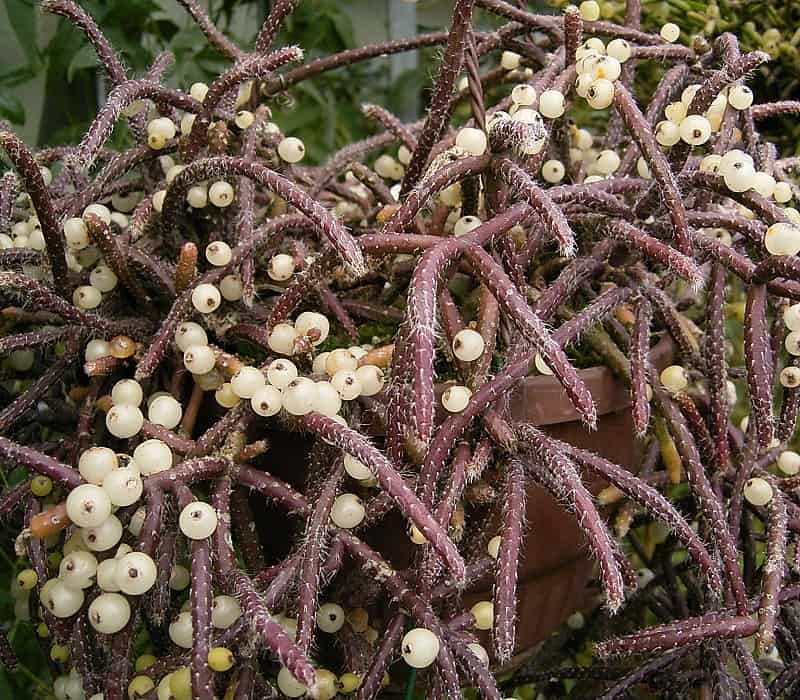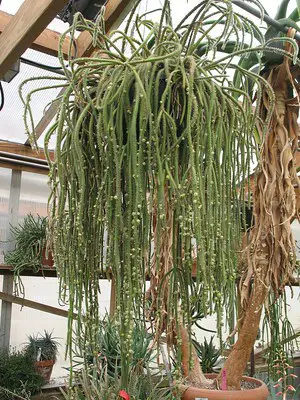This post contains affiliate links. If you buy something from one of our links we may earn a commission. Thanks

Mistletoe Cactus ( Rhipsalis baccifera) is not related to Mistletoe (Viscum album) So instead you will learn all about mistletoe cactus care so you can grow it for yourself.
Mistletoe Cactus Key Takeaways:
- The Mistletoe Cactus (Rhipsalis baccifera) thrives in bright indirect sunlight and high humidity, typical of its native rainforest habitat.
- Water it regularly to keep the soil moist but not waterlogged, and maintain a temperature range of 60-80°F.
- Utilize a well-draining soil mix like coco coir, and fertilize with a diluted liquid fertilizer monthly during the growing season.
- Propagation is easily done through stem cuttings or division.
What Is Mistletoe Cactus
Rhipsalis baccifera is an epiphytic cactus that grows naturally on tree branches beneath the forest canopy and pulls moisture from the air around them.
It bears no relation to Mistletoe (Viscum album) common in Europe so you probably won’t get kissed if you stand under it.
It is an epiphyte and unlike true European mistletoe, it is not parasitic.
Although it originates from Central and South America, and the Caribbean, it is also found throughout the tropics of Africa.
And it can be found as a popular houseplant in cooler climates too.
So in this blog post, you will learn all about Mistletoe Cactus care so you can grow it for yourself.
It is not a difficult plant to grow and makes a stunning hanging basket. So let’s get into it!
Mistletoe Cactus Care
Before we get into the finer points of Mistletoe Cactus care I think it is important to realize this plant grows in a rainforest.
When most folks think of a cactus they think of a desert plant but this is not that type of cactus. If you treat it like that it will very likely die.
How To Care For Rhipsalis In A Nutshell
Mistletoe Cactus Light Requirements
The first thing to understand about this type of cactus is that it needs bright indirect sunlight.
Remember this plant is an epiphyte that grows on trees so it is always partially shaded and it is not a desert cactus that grows in the open.
It cannot tolerate direct sunlight for long periods of time or it will start to get sunburned.
If you live in an area with very intense sunlight like from a south-facing window you might have to filter the light with a sheer curtain.
An east window is perfect if you have one. It will give your cactus a bit of morning sun and bright indirect light the rest of the day.
Mistletoe Cactus Temperature
Mistletoe Cactus will thrive at regular household temperatures. That is one of the reasons it is a popular houseplant.
It will do well at 60-80°. If you keep it outside during the summer be sure to bring it back inside before temperatures fall below 60°.
Mistletoe Cactus Humidity
With Mistletoe Cactus, you pretty much have to forget everything you think you know about cacti.
Although it is a true cactus it is also an epiphyte that grows on tree branches in a tropical rain forest where humidity is high.
The two biggest differences between Mistletoe Cactus and most other cacti are:
1. It prefers indirect sunlight
2. It likes high humidity.
If the humidity in your house is below 50% you should make an effort to raise the plant’s humidity.
You could place it on a pebble tray if it isn’t in a hanging basket. You can also mist the leaves with water in a spray bottle.
If you live in a really dry climate you might want to consider adding a small humidifier near it.
Watering Mistletoe Cactus
The Mistletoe Cactus does not like to dry out. When the potting mix starts to get dry give it a good watering.
This plant prefers to be moist but not waterlogged so don’t overdo it or it may get root rot.
It is best to water it with rainwater or distilled water if you can get it.
Mistletoe Cactus care also includes making sure the plant gets enough humidity.
When you water you can also give it a misting if the humidity in your house is on the dry side (less than 50 %).
Mistletoe Cactus Soil
The Mistletoe Cactus ( Rhipsalis baccifera) is a tropical epiphytic plant in the cactus family that is beloved as a houseplant for its unique pencil-thin foliage and trailing growth habit.
Native to tropical and subtropical regions in South America, Central America, and Africa, the Mistletoe Cactus grows naturally on tree branches beneath the forest canopy, pulling moisture and nutrients from the air around it and the host plant.
While mistletoe cacti are not difficult to grow, they do have specific requirements when it comes to soil, light, water, and humidity.
With a little bit of care, your Mistletoe Cactus can thrive indoors in a pot. They make a great plant for a hanging basket.
A lot of people recommend using cactus or succulent soil for these plants. I am sure they will work just fine but I don’t use them.
Being epiphytes Mistletoe Cactus don’t grow in soil of any kind. Growing on tree branches they are closer to orchids than anything else.
I keep all my plants in coco coir. It is fast draining yet has good moisture retention. Roots really love growing in it too.
It also weighs half as much as a potting mix which might be worth considering if your plant is in a hanging basket.
You can mix it with perlite to speed up the drying rate but you really shouldn’t need to.
Fertilizing Mistletoe Cactus
Mistletoe Cactus are not heavy feeders, but they will benefit from a light application of fertilizer during the growing season.
So an important part of Mistletoe Cactus care also includes fertilizing.
I would recommend using a very diluted liquid fertilizer once a month during the growing season. Just make sure to follow the directions on the package.
You can use a balanced fertilizer formulated for cacti and succulents, or any good well-balanced fertilizer.
When fertilizing Mistletoe Cactus, be sure to avoid getting any fertilizer on the plant’s leaves or stems, as this can cause burning.
Instead, direct the fertilizer to the base of the plant, being careful not to get any on the roots.
Water the plant deeply after applying fertilizer to help distribute nutrients throughout the soil.
Mistletoe Cactus Propagation
Mistletoe Cactus is easy to propagate. It can be propagated with stem cuttings or by division.
To propagate by stem cuttings, take a 4-6 inch cutting from a healthy plant.
You can dip the cut end in rooting powder but it really isn’t necessary.
Plant the cutting in moistened potting mix and place in bright, indirect light.
Keep the soil moist but not soggy until roots have formed and new growth appears.
You can propagate Mistletoe Cactus by division too. The best time to do this is when the plant needs to be repotted.
Divide the root ball into sections using a sharp knife. Make sure each division has roots with top growth attached. Then repot the divisions in new pots with fresh soil.
Mistletoe plants can be grown from seed but this is not an expensive plant to buy and cuttings grow much faster.
I wouldn’t bother but if you really want to here’s how:
To propagate by seed, sow seeds in moistened potting mix and place in bright, indirect light.
Keep the soil moist but not soggy until germination occurs. Once seedlings appear, transplant them to individual pots.
Pruning Mistletoe Cactus
When pruning Mistletoe Cactus you can prune at any time of year if necessary.
To promote bushier growth, pinch back the tips of stems in spring. To control the plant’s size or shape it, prune as needed throughout the growing season.
You can use the prunings to start new plants if you want. If you want a fuller pot you can plant them back in there to help it bush out.
Repotting Mistletoe Cactus
Mistletoe Cactus is a fast-growing plant, so it will need to be repotted every one to two years to prevent it from becoming pot-bound.
When repotting, use a pot that is only slightly larger than the previous one and add some fresh growing medium to the new pot.
Be sure to water deeply after repotting to help settle the roots into their new home.
Is Mistletoe Cactus Toxic?
According to the ASPCA Mistletoe Cactus is not toxic to dogs or cats https://www.aspca.org/pet-care/animal-poison-control/toxic-and-non-toxic-plants/mistletoe-cactus
I also read that the berries are sweet tasting and are edible but I don’t think I would eat them.
Mistletoe Cactus FAQs
The mistletoe cactus is a unique houseplant that offers a blend of easy care and tropical aesthetics.
Its distinctive pencil-thin foliage and trailing growth habit make it a delightful addition to your indoor garden.
Many enthusiasts have questions when it comes to ensuring the health and vibrancy of this epiphytic cactus.
Here, we tackle some common queries to help you on your mistletoe cactus care journey.
Q. What type of soil is most suitable for Mistletoe Cactus?
A. Mistletoe cactus prefers a well-draining soil mix like coco coir, which is light, and fast-draining yet retains adequate moisture. You can also mix in perlite to improve drainage further.
Q. How often should I fertilize my Mistletoe Cactus?
A. A light application of diluted liquid fertilizer once a month during the growing season is ideal.
Ensure to follow the instructions on the fertilizer package to avoid over-fertilizing.
Q. Can Mistletoe Cactus tolerate direct sunlight?
A. No, mistletoe cactus prefers bright, indirect sunlight. Direct sunlight can cause sunburn to the plant.
Positioning it near an east window or filtering intense sunlight with a sheer curtain is advisable.
Q. How do I propagate Mistletoe Cactus?
A. Propagation can be done through stem cuttings or division.
For stem cuttings, take a 4-6 inch cutting and plant it in moistened soil, keeping it in bright, indirect light until roots form.
For division, carefully divide the root ball into sections during repotting, ensuring each division has roots with top growth attached, and repot them in fresh soil.
With the above answers, you’re well-equipped to address common care concerns, ensuring your mistletoe cactus remains a captivating presence in your indoor space.
Mistletoe Cactus Care Final Thoughts

Mistletoe Cactus care is not difficult, but it is important to realize that this plant grows in a rainforest.
If you treat it like a desert plant, it will very likely die.
Mistletoe Cactus needs bright light and regular watering, and the soil should be well-draining.
Mistletoe Cactus can be propagated by stem cuttings, division and from seed.
Pruning is only necessary if the plant becomes too large. Mistletoe Cactus is not toxic to humans or animals.
I hope you give this plant a try so happy gardening and good luck.
https://en.wikipedia.org/wiki/Rhipsalis_baccifera
https://www.indoorvegetablegrower.com/dancing-bones-cactus-care/







